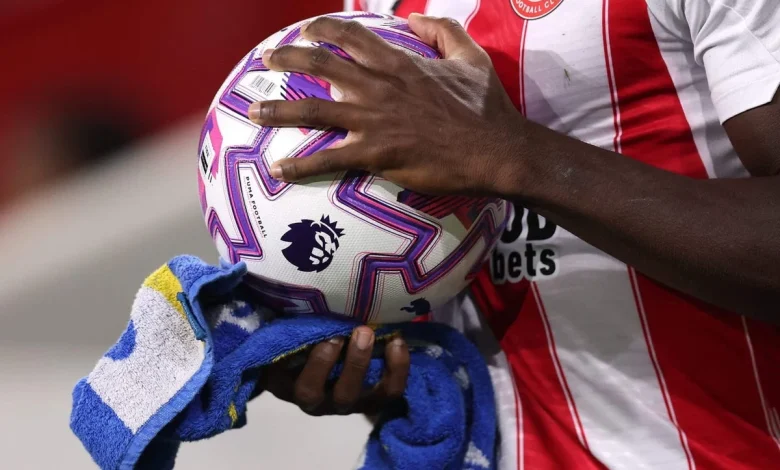Long throws and the striker with no shots on target: A statistical Premier League postcard, 100 games in – The Athletic

There are few neater points of the Premier League season than when the 20 clubs are all 10 games in — 100 matches, 200 results, infinite opinions.
At that point in 2025-26, there have been 22 penalties, 268 goals, 801 shots on target, 86,473 passes and one 15-year-old.
Far too much to explain in its entirety, but plenty of information to boil down into a statistical vignette of the campaign so far. So let’s do precisely that.
Goals (and shots)
The two main strands of goal chat so far have revolved around 1) Erling Haaland and 2) Arsenal.
The former has hit the sort of streak that, as revealed by my colleague Mark Carey this week, could see him score almost 100 goals by the end of the season.
Ten games into the new Premier League campaign, Haaland has more goals on his own than half of the teams taking part in it. He is two short of a century in the division for his career and in the 137-year history of the English top flight, only 258 players have scored more times than he has. He’s been here three years. Oh, and he has a higher xG number this season than Tottenham Hotspur, although it should probably be pointed out that only teams to have employed Tim Sherwood as their manager (Spurs and Aston Villa) have stopped Haaland scoring over these first few months.
So if you enjoy goals, do check out Haaland, but if you prefer the opposite, then Arsenal are very much the lads for you.
Mikel Arteta’s side are on course to concede 11 goals in the 2025-26 Premier League, which would shatter Chelsea’s record of 15 in 2004-05 (which, let’s be honest, took some of the shine off Arsenal’s Invincibles season a year earlier).
They did concede to Haaland — of course they did — but the last time any team scored against Arsenal, in any competition, was in late September. Since then, around 16 million humans have been born (roughly equal to the combined populations of Switzerland and Serbia), a vast swathe of people who simply don’t understand that it is theoretically possible for David Raya to let a ball go past him into the net.
Arsenal are currently on track to concede fewer goals in 2025-26 than Tottenham did in April
— Duncan Alexander (@oilysailor) November 3, 2025
But not everyone can be Haaland or play in Arsenal’s defence.
There has seemingly been a statistical anomaly vortex hovering over Merseyside so far this season, for good and bad. There’s Jack Grealish, with twice as many assists already for Everton as he managed in his previous two seasons at Manchester City combined.
But there’s also Thierno Barry, who is still to register a shot on target with his new team, 10 games in. Perhaps it’s an Everton thing, because their former player Bernard holds the admittedly niche record for ‘forward with most appearances before registering a shot on target’, at 27 games.
And then there’s the potential return of the rarely-seen ‘Stewart Downing Season’, last witnessed in the Premier League in 2011-12. Back then, the England winger — signed by Liverpool in the summer of 2011 — had one of the oddest campaigns on record, ending it having taken the most shots (72) without scoring and creating the most chances (55) without seeing any of them turned into an assist.
What’s its relevance now, you ask? Well, as it stands, 33 Premier League players have reached double figures for both shots and chances created this season but Florian Wirtz is the only one of them yet to provide a goal or an assist.
Will he do so soon? Almost certainly, just as Barry will test a goalkeeper in the near future, but it’s still interesting to examine these things.
The inevitability of set pieces
Another talking point has been set pieces, a new way of scoring invented last summer, or so someone new to football might think. In reality, the long throw, the in-swinging corner, the crowd scene in the box, the referee delaying an indirect free kick so he can discuss grappling with two players who nod solemnly — it’s all part of the fabric of the Premier League.
In fact, the very first goal in the competition’s history, scored by Brian Deane against Manchester United on August 15, 1992, came from a very familiar situation. Does Barry Davies’ commentary convey surprise at Sheffield United’s tactics? Not really.
The first ever @premierleague goal 🙌
Brian Deane got two as the Blades beat Manchester United on the opening day in ’92 💪 pic.twitter.com/B871OLM1Zp
— Sheffield United (@SheffieldUnited) November 22, 2019
Zooming forward 33 years to the present day, the long throw is not only back in fashion but we can assess its value in a way the people at Bramall Lane that summer afternoon in 1992 couldn’t have envisaged.
Nearly everyone’s at it, but it’s two London clubs, Brentford and Crystal Palace, who are leading the way.
Keith Andrews’ team have launched the most long throws into the penalty area (50), but it’s Oliver Glasner’s Palace who have generated the most expected goals from their throw-ins (2.1 xG), which have an incredibly neat split of 22 from the attacking left and 22 from the right.
Meanwhile, the player to have generated the most xG (based on shots taken within 10 seconds of a long throw) is Sunderland’s Nordi Mukiele with 1.4. Something for Arsenal to be aware of at the Stadium of Light on Saturday evening.
Mukiele preparing to generate some more xG on the touchline (George Wood/Getty Images)
Whether all this set-piece focus is good for the game is a matter of debate, but while teams continue to find success from doing it, it’s not going to stop.
Looking at the league table
But when all is said and done, people just enjoy sitting around and looking at league tables, and always will. And 10 games into a campaign is surely the most aesthetically satisfying moment of a season because each team’s W-D-L record can be read as a formation.
It’s a bumper crop in 2025-26 too, with a 4-4-2 (Palace, ironically) for the third time in the past five seasons, after only witnessing it three times from 2006-07 to 2020-21. There’s a periodically on-brand 5-3-2 from Sunderland, a squint-and-it-works 5-2-3 for Manchester United and a sort-of-fair-enough 4-3-3 at both Brighton & Hove Albion and Aston Villa.
Such a mixture of wins, draws and defeats speaks to a more congested table than we have seen at this stage, so it feels counterintuitive that this is the first season in English top-flight history to see one team, Liverpool, lead the league by five points or more after five games, then a different one, Arsenal, leading by five or more five games later. Arne Slot’s defending champions have shown how quickly a season’s trajectory can shift, though right now it feels unlikely Arteta’s side have four successive defeats in their locker.
Lower down the standings, the three promoted teams have 39 points between them, already 66 per cent of the total Leicester City, Southampton and Ipswich Town managed in the whole of last season.
It suggests we could be in for a particularly rigorous relegation battle, which is great news for fans of Our League after the past few campaigns. The last team to be relegated with 36+ points were Newcastle United in 2015-16, while 2010-11 saw both Birmingham City and Blackpool go down despite picking up 39.
Could we be in for a long-awaited legitimate use of the phrase, ‘We just need to get to 40 points’?





